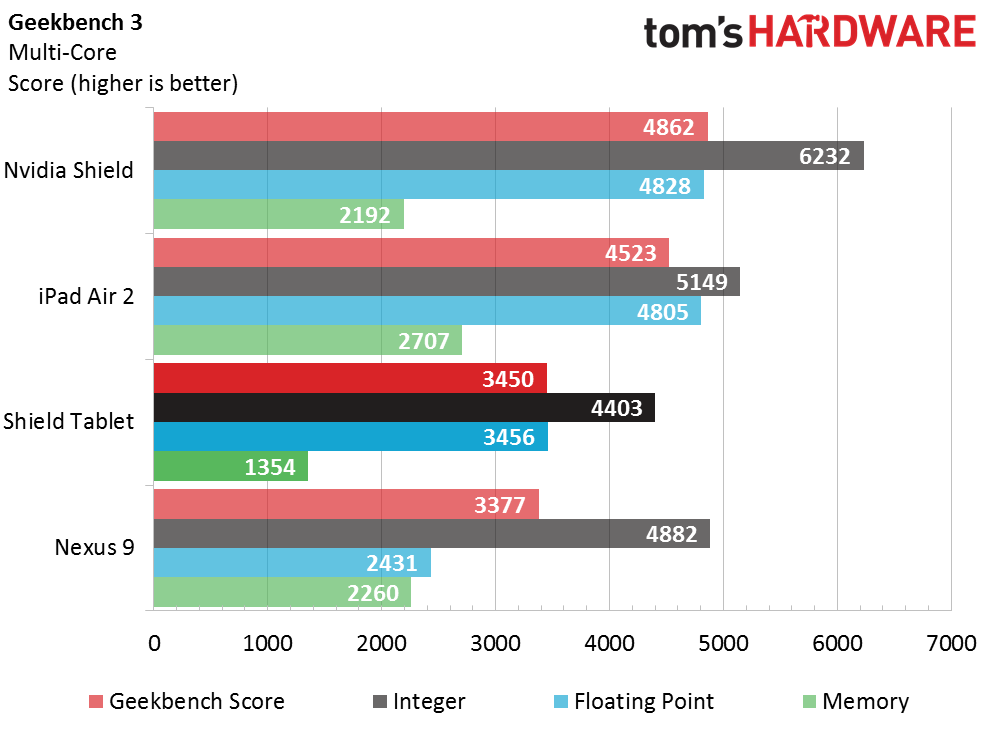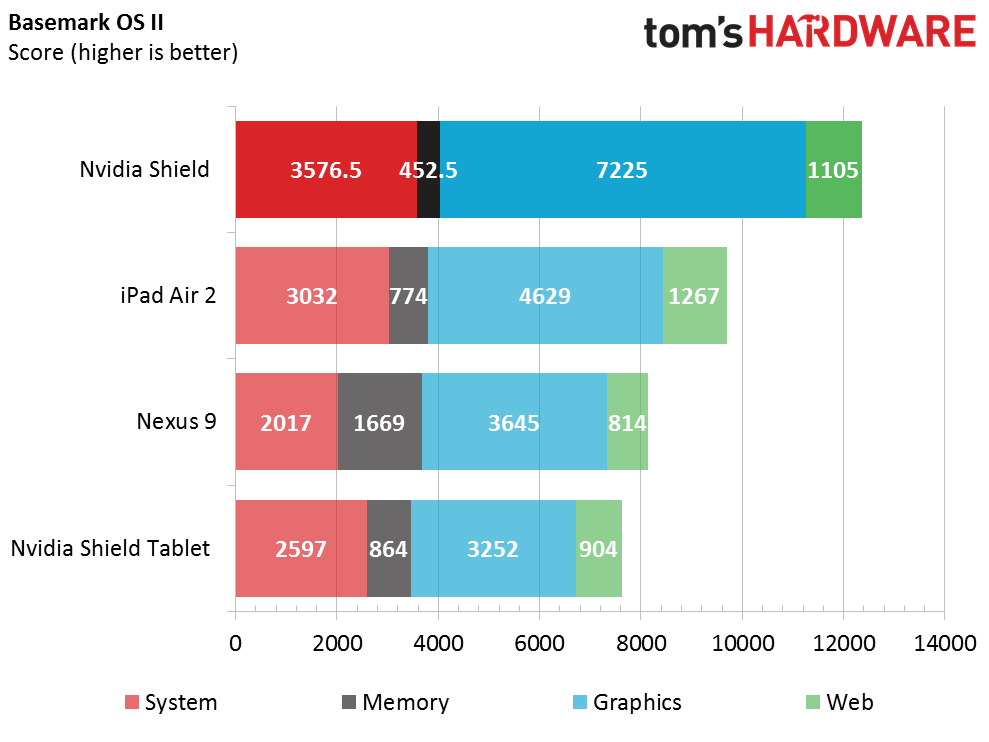Nvidia Shield Android TV Console Review
Today we take a look at the latest addition to Nvidia's Shield line of gaming devices. No mobility here, this new Shield is for the living room!
Why you can trust Tom's Hardware
CPU Core Benchmarks
Basemark OS II
Basemark OS II is a cross-platform mobile device benchmarking tool that scores overall performance by looking at several different specs; System, Memory, Graphics and Web. For System performance, Basemark looks at single- and multi-core CPU speeds, math testing, and XML parsing performance. The Memory portion of the benchmark looks at the read/write speeds of the device’s internal storage using fixed and growing files of different sizes. Graphics scores a device’s ability to handle 2D/3D effects as different operations get applied. Lastly, Web looks at system performance during the manipulation of CSS 3D and HTML5 objects, including transformations and resizing.
As we’ll see in the upcoming Geekbench 3 results, it seems like memory is the Nvidia Shield’s key deficiency. Probably a weakness due to a focus on graphics, we can see from the scoring that the Tegra X1-powered Shield relies heavily on its SoC, but with the machine's focus on gaming and video, we already know who Nvidia is trying to please.
Geekbench 3
Our second test is Primate Labs’ Geekbench. Also a cross-platform testing suite that covers Windows, Linux, OS X, iOS and Android, Geekbench produces two sets of results; one for single-core processing and the other for multi-core processing. The overall Geekbench Score for each of the two benchmarks is a product of three individual sub-tests that score on integer, floating point and memory testing.


The single-core results for the Nvidia Shield are underwhelming, and if the year were 1992, I would probably care more. Being that we’re now in an era that bleeds multi-core computing, we should probably look to focus on multi-core results instead. I’m not saying that there’s nothing important about the single-core testing since it does emphasize the importance of cache sizing and other supporting tech, but in the end we want to see the processor shine.
In the multi-core case, the Shield and it’s Tegra X1 SoC do shine, especially in the integer testing. For floating point calculations, the Shield ekes out ahead of the iPad Air 2, but falls behind in the memory/storage testing.
Get Tom's Hardware's best news and in-depth reviews, straight to your inbox.
Current page: CPU Core Benchmarks
Prev Page Benchmarking Suites And Test Notes Next Page GPU Core Benchmarks-
jasonelmore keep the shield devices coming nvidia! that gpu score.. can't wait to see it in their tablet next month.Reply -
Per Wigren FINALLY a review that tests GameStream. I can't believe how there can be so many reviews out there and just about no one that bothers to try this rather major feature, considering it's produced by Nvidia and comes with a gamepad... Thank you!Reply
The result is rather discouraging, however. Did you use it at 1920x1080 at 60 FPS? Was the game set to that resolution on the PC as well? -
Valld Nice review, just a few mistakes in the specifications:Reply
1. There are moving parts inside - the cooling fan, clearly visible on the photo
2. Bluetooth version is 4.1/BLE, not 2.1
3. Micro SD card slot supports cards up to 128Gb, not 2Tb -
Eggz Interesting! People with HTPCs will be looking for something given that Windows 10 won't have Windows Media Center any more.Reply
I think that creates an open market, and I'm curious to see whether Ceton will hire some programmers to come up with a piece of software that supports all of the WMC functionality, and whether they or anyone else will solve the OnDemand functionality issue that's now exclusive to cable boxes. -
Zepid What a shit review. No codec information, no playback benchmarks for local media. No information as to if you can mount USB storage to be readable natively by Android apps (as in can I plug in a USB HDD and see it without doing anything in say... VLC). Because Android TV doesn't support this by default without a root or custom ROM, I assume Nvidia has this feature enabled but ZERO REVIEWERS have bothered mentioning it.Reply -
clonazepam Where's the gamepad review? Stream Dark Souls I/II to the thing and really hammer on the d-pad with weapon swaps / item use, and report back. Thanks! :)Reply
"Git gud casul." -
Emanuel Elmo I made this correction before and nobody seems to have corrected it.Reply
The $299.99 model of the shield comes with a 500GB HDD and NOT a 200GB HDD.
I will say this again that it can be confirmed off of the Nvidia website. -
thrus Something that bugged me early in the article since your internet was only 23Mbps you couldn't reliably stream 4k from Netflix, but the gigabit port make HD work fine. If the port was all that mattered it far exceeded the recommended 25Mbps for 4k as well. The gig port had nothing to do with your streaming, heck an old 100Mbps port would be 4 fold the required throughput for 4k. keep the specs in the specs section and don't try to shoehorn them in where they are irreverent.Reply -
deppman I have the 500GB Shield. The Talos Principle can be set to 1080p rendering and it looks and performs very well. I'm not sure why it defaults to 720p rendering. The Wi-Fi results in less lags and hiccups than the Shield Tablet, so game streaming is better nearly glitch-free IF your network isn't busy. Video streaming is flawless, and even Chromecast improves. Also, Google just released 600 more TV apps, so selection is greatly improved. Now if I could only install a browser.Reply
